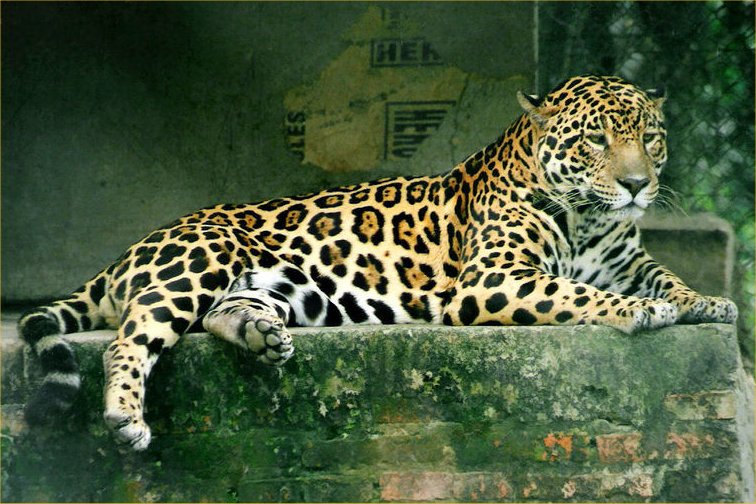Well, I sometimes use these fun facts as a means of imparting on my limited readership aspects of zoology which many people do not notice or often mistake. In other words, I have "pet peeves", things that people often mix up or forget about certain animals. The difference between apes and monkeys, for example. Today, I'll highlight another such common misconception: the notion of a "panther".

Now, first let us define what makes a panther. Basically, a panther is a big cat, one that specifically displays dark (nearly black coloration). Now, as I understand it, it is a common misconception that the panther is a species all it's own, but the real answer's a bit less impressive. Now, there is such thing as a florida panther, which a subspecies of cougar, but the black individuals in discussion here are not. In fact, "panther" as it relates to an all-black big cat is just a nickname for a particular genetic variety of two species of cats: the jaguar (
Panthera onca) and the leopard (
Panthera pardus).

As most people well know, both of these cats are tan or yellow with brown and black spots covering their fur. The jaguar has larger spots, with smaller dots inside, and is found in South and Central America. The leopard has smaller spots, and is found throughout Africa, Asia, and even parts of the middle east. Now, both of these animals typically have this color pattern, but both also contain genes for melanism, which is the term for the all-black version of fur coloration. In the jaguar, this gene is recessive, and in the leopard, it is dominant. It is rare, but when expressed, it produces an all black version of the animal, thus creating a "panther".

Therefore, panther is not actually a species, but rather just a black version of either a jaguar or a leopard. In fact, if one looks closely, you can actually still see spots on black jaguars and leopards, further evidence to their genetic components. So, now you know, if you, didn't before.
 Now, first let us define what makes a panther. Basically, a panther is a big cat, one that specifically displays dark (nearly black coloration). Now, as I understand it, it is a common misconception that the panther is a species all it's own, but the real answer's a bit less impressive. Now, there is such thing as a florida panther, which a subspecies of cougar, but the black individuals in discussion here are not. In fact, "panther" as it relates to an all-black big cat is just a nickname for a particular genetic variety of two species of cats: the jaguar (Panthera onca) and the leopard (Panthera pardus).
Now, first let us define what makes a panther. Basically, a panther is a big cat, one that specifically displays dark (nearly black coloration). Now, as I understand it, it is a common misconception that the panther is a species all it's own, but the real answer's a bit less impressive. Now, there is such thing as a florida panther, which a subspecies of cougar, but the black individuals in discussion here are not. In fact, "panther" as it relates to an all-black big cat is just a nickname for a particular genetic variety of two species of cats: the jaguar (Panthera onca) and the leopard (Panthera pardus).  As most people well know, both of these cats are tan or yellow with brown and black spots covering their fur. The jaguar has larger spots, with smaller dots inside, and is found in South and Central America. The leopard has smaller spots, and is found throughout Africa, Asia, and even parts of the middle east. Now, both of these animals typically have this color pattern, but both also contain genes for melanism, which is the term for the all-black version of fur coloration. In the jaguar, this gene is recessive, and in the leopard, it is dominant. It is rare, but when expressed, it produces an all black version of the animal, thus creating a "panther".
As most people well know, both of these cats are tan or yellow with brown and black spots covering their fur. The jaguar has larger spots, with smaller dots inside, and is found in South and Central America. The leopard has smaller spots, and is found throughout Africa, Asia, and even parts of the middle east. Now, both of these animals typically have this color pattern, but both also contain genes for melanism, which is the term for the all-black version of fur coloration. In the jaguar, this gene is recessive, and in the leopard, it is dominant. It is rare, but when expressed, it produces an all black version of the animal, thus creating a "panther".  Therefore, panther is not actually a species, but rather just a black version of either a jaguar or a leopard. In fact, if one looks closely, you can actually still see spots on black jaguars and leopards, further evidence to their genetic components. So, now you know, if you, didn't before.
Therefore, panther is not actually a species, but rather just a black version of either a jaguar or a leopard. In fact, if one looks closely, you can actually still see spots on black jaguars and leopards, further evidence to their genetic components. So, now you know, if you, didn't before.
No comments:
Post a Comment